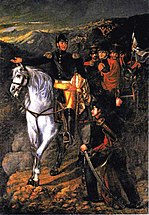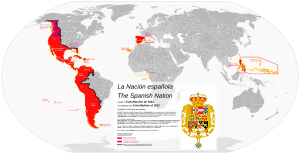 Global Information
Global InformationSpanish American wars of independence information
| Spanish American wars of independence | |||||||||
|---|---|---|---|---|---|---|---|---|---|
| Part of the Atlantic Revolutions,[3] the Decolonization of the Americas, and the Napoleonic Wars | |||||||||
    From left to right, top to bottom: the Congress of Chilpancingo (1813), the Congress of Cúcuta (1821), the Crossing of the Andes (1817), the extent of the Spanish Empire on the eve of the conflict in 1810, according to the Cortes de Cádiz | |||||||||
| |||||||||
| Participants | |||||||||
|
| ||||||||
| Units involved | |||||||||
|
| ||||||||
| Strength | |||||||||
|
| ||||||||
| Casualties and losses | |||||||||
|
| ||||||||
| 600,000 total dead[5] | |||||||||
The Spanish American wars of independence (Spanish: Guerras de independencia hispanoamericanas) took place throughout Spanish America during the early 19th century, with the aim of political independence from Spanish rule.[6] Struggles for sovereignty in both hemispheres began shortly after the outbreak of the Peninsular War as a front in the larger Napoleonic Wars, between royalists who favored a unitary monarchy, and patriots who favored either plural monarchies or republics.[7] Thus, the strict period of military campaigns would go from the Battle of Chacaltaya (1809), in present-day Bolivia, to the Battle of Tampico (1829) in Mexico.[8][9]
In 1808, the abduction of the Spanish royal family by Napoleon Bonaparte, the Abdications of Bayonne, gave rise two years later to an emergence of liberalism and desire for liberties throughout the Spanish Empire. At first, some major cities or capitals formed local Juntas on the basis of laws from the Hispanic tradition. The violent conflicts started in 1809, with short-lived juntas established to govern in Chuquisaca, La Paz and Quito opposing the government of the Supreme Central Junta of Seville. At the beginning of 1810, new juntas appeared across Spanish America when the Central Junta fell to the French invasion. Although various regions objected to many crown policies, "there was little interest in outright independence; indeed there was widespread support for the Spanish Central Junta formed to lead the resistance against the French".[10] While some Spanish Americans believed that independence was necessary, most who initially supported the creation of the new governments saw them as a means to preserve the region's autonomy from the French. Although there had been research on the idea of a separate Spanish American ("creole") identity separate from that of Iberia,[11] political independence was not initially the aim of most Spanish Americans, nor was it necessarily inevitable.[12]
At the end of 1810, Ferdinand VII of Spain, captive, was recognized by the Cortes of Cádiz and by the governing juntas in the Americas as a king subordinate to popular sovereignty. The governing juntas across America wanted to reinstate Ferdinand VII as king and refused to accept the authority of the Council of Regency that was established with the dissolution of the Supreme and Central Governmental Junta of Spain and the Indies. In agreement on this, a military conflict arose between Royalists and Patriots over the unity or independence of the empire. These juntas gained their own levels of independence and autonomy from Spain through declarations in 1808-1812.[13] However, Ferdinand VII reimposed absolute monarchy in 1814 with a coup d'état, following the defeat of Napoleon and the Treaty of Valençay. He was able to defeat and repress the peninsular liberals, and abolished the liberal Constitution of Cadiz, although he could not defeat the revolutionaries in Spanish America, who resisted and formed their own national congresses. The Spanish navy had collapsed in the war against Napoleon, so therefore, in practice, it did not support the expeditionary forces who arrived in small groups. In 1820 the Spanish army, led by Rafael Riego, revolted against absolutism, restored the so-called Trienio Liberal, and ended the threat of invasion against the Río de la Plata, resulting in royalist collapse in Americas. Over the course of the next decade, the Patriots’ armies won major victories and obtained independence in their respective countries. Spain did not change the position against separatism, but the political instability in Spain, without a navy, army or treasury, convinced many Spanish Americans of the need to formally establish independence from the metropole. In Spain, a French army of the Holy Alliance invaded and supported the absolutists, restored Ferdinand VII, and occupied Spain until 1828.[14]
These conflicts were fought both as irregular warfare and conventional warfare. Some historians claim that the wars began as localized civil wars,[15] that later spread and expanded as secessionist wars[16][17][18][19] to promote general independence from Spanish rule.[20] This independence led to the development of new national boundaries based on the colonial provinces, which would form the future independent countries that constituted contemporary Latin America during the early 19th century.[20] Cuba and Puerto Rico remained under Spanish rule until the 1898 Spanish–American War.
The conflict resulted in the dissolution of the Spanish monarchy and the creation of new states. The independence of Spanish America did not constitute an anticolonial movement.[21] Slavery was not abolished in most new countries, but the new republics immediately left the formal system of racial classification and hierarchy, the caste system, the Inquisition, and noble titles. Criollos of Spanish descent born in the New World, and mestizos of mixed Indigenous and European heritage replaced Spanish-born appointees in most political governments. Criollos remained at the top of a social structure that retained some of its traditional features culturally, if not legally. Slavery finally ended in all of the new nations. For almost a century thereafter, conservatives and liberals fought to reverse or to deepen the social and political changes unleashed by those rebellions. The Spanish American independences had as a direct consequence the forced displacement of the royalist Spanish population that suffered a forced emigration during the war and later, due to the laws of Expulsion of the Spaniards from the new states in the Americas with the purpose of consolidating their independence.[22]
Events in Spanish America transpired in the wake of the successful Haitian Revolution and transition to independence in Brazil. Brazil's independence in particular shared a common starting point with that of Spanish America, since both conflicts were triggered by Napoleon's invasion of the Iberian Peninsula, which forced the Portuguese royal family to flee to Brazil in 1807. The process of Latin American independence took place in the general political and intellectual climate of popular sovereignty that emerged from the Age of Enlightenment that influenced all of the Atlantic Revolutions, including the earlier revolutions in the United States and France. A more direct cause of the Spanish American wars of independence were the unique developments occurring within the Kingdom of Spain triggered by the Cortes of Cadiz, concluding with the emergence of the new Spanish American republics in the post-Napoleonic world.
- ^ Frank L. Owsley, Gene A. Smith (1997), Filibusters and Expansionists: Jeffersonian Manifest Destiny, 1800–1821
- ^ Meade, Teresa (2016). A History of Modern Latin America 1800 To The Present. Wiley. p. 78.
- ^ Klooster, Wim (2018). Revolutions in the Atlantic World. NYU Press. ISBN 9781479882403. Archived from the original on 1 February 2024. Retrieved 26 September 2023.
- ^ a b Gral. Div. (R) Evergisto de Vergara. "The Eastern Front: Rivadavia and the War against Brazil in 1827." Archived May 15, 2013 at the Wayback Machine. Institute for Strategic Studies of Buenos Aires (IEEBA). August 2006. Quote: "Y fue una gran guerra civil, porque en Ibero América -para la época de las Guerras por la Independencia- había menos de 50.000 soldados españoles, de los cuales 20.000 nunca salieron de Cuba. Luego, en el proceso de las guerras por la independencia, nunca participaron más de 30.000 españoles. Por ejemplo, en Ayacucho, la última de las batallas por la independencia, menos del 20% de las tropas eran españoles, el resto eran nativos. Los nativos de Ibero América que murieron durante estas guerras fueron aproximadamente 35.000. Fueron verdaderas guerras civiles, y por lo tanto, dejaron mucho más destrucción y rencores."
- ^ "Victimario Histórico Militar". Archived from the original on 9 May 2008. Retrieved 12 October 2017.
- ^ Canal, Jordi (2006). "Civil War and Counter-Revolution in Spain and the Southern Europe on XIX Century". Ler História. 51. Archived from the original on 1 February 2024. Retrieved 22 June 2023.
- ^ Peire, Jaime (2014). "El Río de la Plata y las Cortes de Cádiz: ¿un juego de máscaras?". Revista Venezolana de Análisis de Coyuntura. Universidad Central de Venezuela Venezuela (in Spanish). XX: 35.
- ^ Rufino Blanco-Fombona (1920). Fundación de la República - Biblioteca Ayacucho nº 61. p. 67.
- ^ Lara, Maria (2018). Breviario de historia de España.
- ^ David Bushnell, " Wars of Independence: South America" in The Encyclopedia of Latin American History and Culture, vol. 5, p. 446. New York: Charles Scribner's Sons 1996.
- ^ D.A. Brading, The First America: The Spanish Monarchy, Creole Patriots, and Liberalism, 1492–1866. Cambridge: Cambridge University Press 1991
- ^ Brian Hamnett, The End of Iberian Rule on the American Continent, 1770–1830. Cambridge: Cambridge University Press 2017.
- ^ Spanish American Revolutions. (n.d.). Retrieved April 22, 2024, from https://www.brown.edu/Facilities/John_Carter_Brown_Library/exhibitions/spanishage/pages/juntas.html
- ^ Timothy Anna,"Review", American Historical Review vol. 123 (3) 2018, pp. 985–86.
- ^ Kinsbruner, Jay (1994). Independence in Spanish America: Civil Wars, Revolutions, and Underdevelopment. University of New Mexico press. ISBN 978-0826321770.
- ^ Strachan, Hew (2011). The Changing Character of War. p. 206.
- ^ Kinsbruner, Jay (2000). Independence in Spanish America: Civil Wars, Revolutions, and Underdevelopment.
- ^ Lu, Jing (2018). On State Secession from International Law Perspectives. p. 14.
- ^ Rospide, Santiago Miguel (2021). "¿Por qué los españoles rechazaron la propuesta del General San Martín de coronar un príncipe Borbón en el Perú?". ReDiU, Revista Digital Universitaria del Colegio Militar de la Nación.
- ^ a b Hamnett, Brian R. (May 1997). "Process and Pattern: A Re-examination of the Ibero-American Independence Movements, 1808–1826". Journal of Latin American Studies. 29 (2): 279–328. doi:10.1017/s0022216x97004719. ISSN 0022-216X. S2CID 145479092.
- ^ Rodriguez, Jaime (2009). "The Hispanic Revolution: Spain and America, 1808-1826". História: Política e Revolução, 1945-1975. 57.
- ^ Ruiz de Gordejuela Urquijo, Jesús (2006). La expulsión de los españoles de México y su destino incierto, 1821-1836 (in Spanish). Consejo Superior de Investigaciones Científicas, Escuela de Estudios Hispano-Americanos & Universidad de Sevilla. ISBN 978-840-0084-67-7.